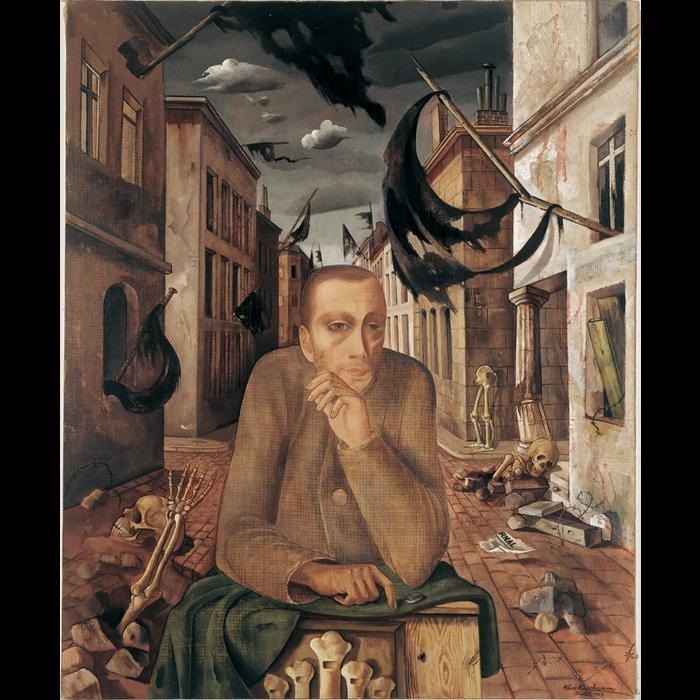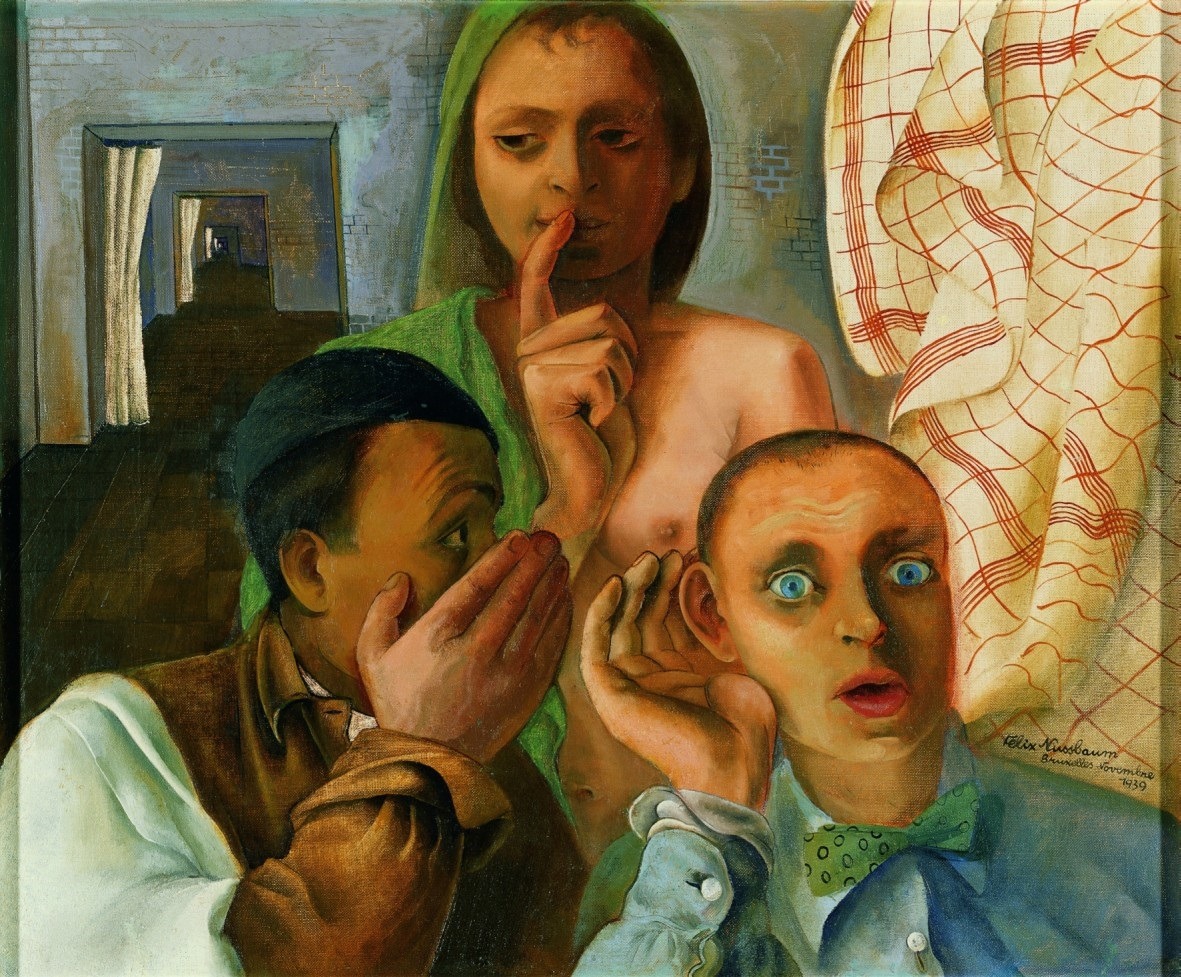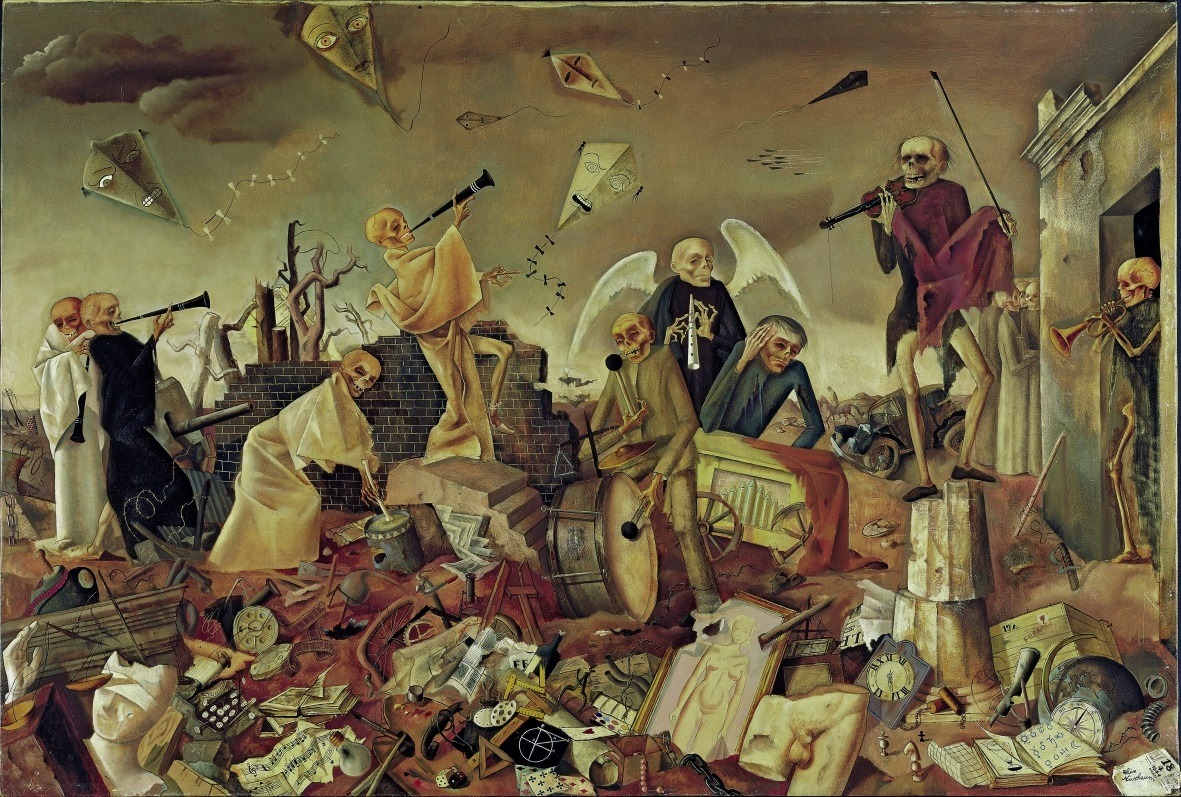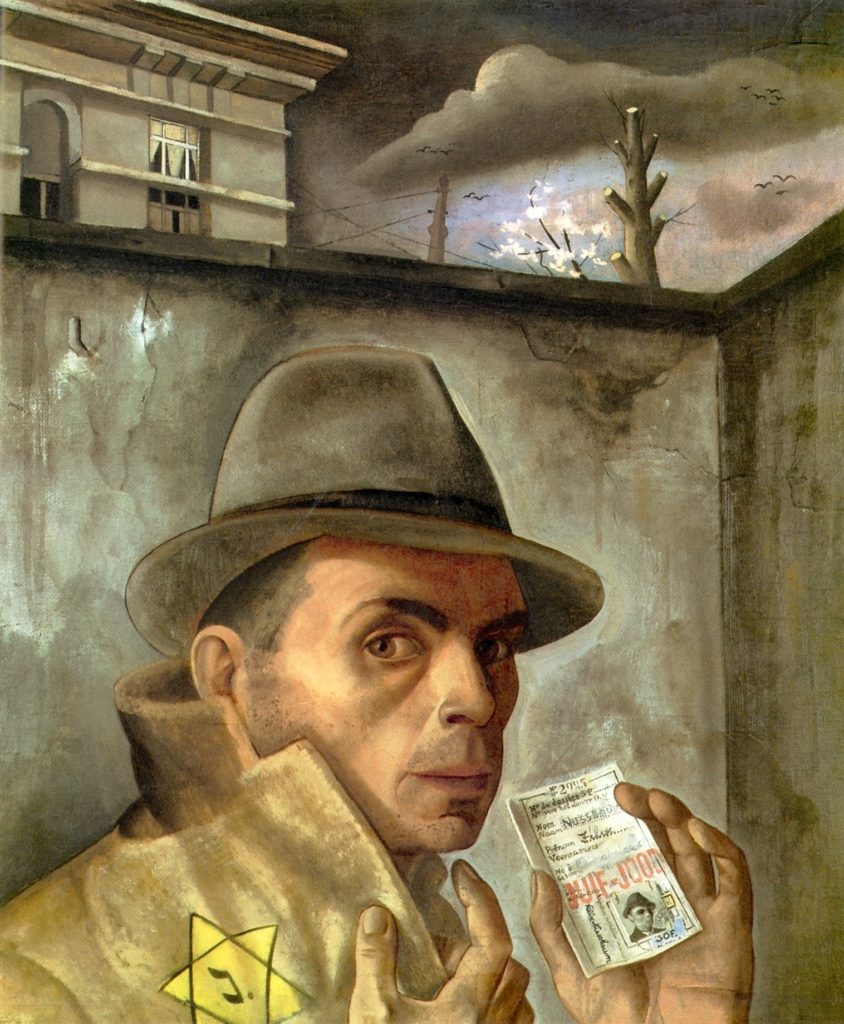“When I perish, do not allow my pictures to die with me. Show them to the people.”
Felix Nussbaum (1904 – 1944) was a Jewish-German painter who lived in Brussels until he was caught by the Nazis and deported to his death in Auschwitz.
In a new book Belgian author and journalist Mark Schaevers follows in the footsteps of Nussbaum. He traces his paintings and analyses their meaning against the background of the artist’s personal experiences during his life in exile. The book is called “Orgelman. Felix Nussbaum – een schildersleven” (the life of an artist). A translation into German is expected.
When I met Mark to interview him he didn’t wait for my questions and started explaining the name of his book. Orgelman in Flemish is someone who plays or grinds an organ. It’s a motive which figures in several of Felix Nussbaum’s paintings.
“The organ player in the past may be seen as a metaphor for the wandering Jew because there were often Jewish players in the streets of European cities. Nussbaum identified himself with them as he himself had to wander around in exile. But it’s also a metaphor for Nussbaum himself as an artist looking for an echo which he had lost when he was driven into exile. In one of his last paintings from 1943, the organ-pipes have changed into bones.”

“Organ-Grinder", 1942/1943, Felix-Nussbaum-Haus Osnabrück, Leihgabe der Niedersächsischen © VG Bild-Kunst, Bonn 2014
Mark explains why he took such an interest in Nussbaum that he decided to write a book about him. In a previous book he wrote about a Jewish colony of authors and artists who lived in exile in the mid-thirties in Ostend at the coast of Belgium. Nussbaum was one of them. The first paintings by Nussbaum which Mark saw were harbor views from the Ostend period.
“It was a story that I couldn’t refuse to tell,” Mark says. “It can be compared with the story about Anne Frank. Instead of a diary we have the paintings where Felix documented his life in hiding. In Osnabrück in Germany, where he was born, a new museum with his paintings has risen like a Fenix from the ashes.”
Felix Nussbaum came from an assimilated middle-class Jewish-German family. His father who had painting as a hobby supported his plans to become an artist. An early painting by him, at the age of 21, shows the interior of the synagogue in Osnabrück and has been interpreted as an expression of his Jewish faith.

“The Painter in his Studio”, 1931 Privatsammlung © VG Bild-Kunst, Bonn 2014
“When growing up as an artist Felix abandoned the Jewish religion, but during his exile years he always felt solidarity with his fellow-Jews. He couldn’t escape his Jewish identity. From being an apolitical painter he became a resistance painter.”
Mark quotes the famous Jewish-Italian author Primo Levi, who survived Auschwitz, and wrote: “Now I’m really a Jew. They sew the star of David on me, and not only on my coat.”
From Osnabrück Nussbaum moved to Berlin to study art. In 1932 he received a grant to study art at the German Academy in Rome. He was never to return to Germany. From Rome he travelled to the Italian Riviera, Paris, Ostend and finally Brussels.
His life is closely linked to Brussels although he and his wife never received any Belgian identity cards. Here he was living and painting during the years 1936 – 1944. In fact he lived at different addresses in what now is the European quarter of Brussels – Justus Lipsius and Archimède. For Mark it’s a strange coincidence that Nussbaum happened to live near Berlaymont, the very heart of the European Union today.
“Nussbaum represents the bloody past of recent European history when so many people perished and were killed for no reason. The European Common Market, later transformed into the European Union, was established in order to reconcile countries that had been at war against each-others for centuries and to ensure a peaceful Europe.”
[caption id="attachment_30948" align="alignnone" width="280"] “The Secret”, 1939: Osnabrück, Privatbesitz © VG Bild-Kunst, Leihgabe, Bonn 2014. [/caption]
“The Secret”, 1939: Osnabrück, Privatbesitz © VG Bild-Kunst, Leihgabe, Bonn 2014. [/caption]
[caption id="attachment_30949" align="alignnone" width="282"] “The Refugee”, 1939, Felix-Nussbaum-Haus Osnabrück, Irmgard und Hubert Schlenke, Ochtrup © VG Bild-Kunst, Bonn 2014[/caption]
“The Refugee”, 1939, Felix-Nussbaum-Haus Osnabrück, Irmgard und Hubert Schlenke, Ochtrup © VG Bild-Kunst, Bonn 2014[/caption]
In Brussels, in October 1937, Nussbaum married his life-long partner and fellow-artist Felka Platek whom he had met in 1924. His last one-person exhibition took place in Brussels in February 1939. The couple was living at rue Archimède 22 during most of the time after their marriage.
On the 10th of May 1940, the day the German troops invaded Belgium, he was arrested by the Belgian authorities and sent to an internment camp near the Pyrenees in France. After a few months he managed to escape and return to Brussels where he depicted life in the camp in chilling paintings.
During their two last years in Belgium, 1942 – 1944, the couple was hiding in an attic of the building at rue Archimède. On 20 June 1944 Felix and Felka were arrested. The Gestapo must have been tipped by an informer, who saw them opening at times the window of the attic. No denouncement letter has ever been found which would disclose the informer’s identity.
From Brussels Felix and his wife were taken by Gestapo to the detention camp at Kazerne Dossin in Mechelen. From there they were deported on the last train to leave Belgium for the death camp in Auschwitz-Birkenau. Only 5 % of the 25 000 Jews and 352 Roma who were deported to Auschwitz-Birkenau during 1942 – 1944 survived.
It was thought that he was killed immediately on his arrival on 2 August 1944 but now we aren’t sure about his death day. According to new documents found in Soviet military archives, Nussbaum was in a hospital barrack on 20 September. If he hadn’t been denounced by an informer he would have lived to experience the liberation of Brussels on 3 September 1944 by allied forces.
In recent years, plaques in three languages; Dutch, German and French, were fixed to the wall of the house at rue Archimède, now the back side of a hotel building, to commemorate his memory. There are also two stones in the pavement with his and his wife’s names just opposite the street number (22) of the building, as in Berlin and other German cities.
Aware of the inevitable death that faced all Jews in the hands of Nazi-Germany, Nussbaum took precautions to preserve and hide his paintings. The fate of his paintings reads almost as a detective story.
When the house at rue Archimède was torn down in 1983, some twenty photographs of his paintings were found, which Felix had hidden in the attic where they themselves were hiding. Many paintings were stored with friends or at the ateliers where he was working. Other paintings were left by Nussbaum’s parents in Amsterdam where they had taken refuge. They were also murdered in Auschwitz.
After the war some of the persons who had been keeping his paintings would become entangled in legal disputes about the ownership of his paintings. After lengthy proceedings, Nussbaum’s surviving relatives were given custody of most of the paintings and a large collection was bought by the Felix Nussbaum House in Osnabrück, a brand-new museum established in 1998.
How would you describe Nussbaum’s development as a painter?
“Nussbaum was recognized as prominent painter already in the early 30-ies,” Mark explains. “Even the New York Times mentioned his great breakthrough painting ‘Der Tolle Platz’ in 1931. Unfortunately his Berlin atelier was destroyed in a fire in 1932 with 150 of his paintings. After the war, hardly any paintings of him were known, but since then hundreds of paintings and gouaches have been found.
“Nussbaum was seen as an exponent of German post-expressionism although I myself find it difficult to put him under the heading of any style. During his youth he absorbed different influences, including from Van Gogh and De Chiroco. He was prolific during the inter-war period and would have become a famous painter if Nazism hadn’t come to power in Germany.
“Some of his best paintings are from his last years when he was living in exile and suffered persecutions. Because of the tragic circumstances during the war he became a unique painter. After the war he has become increasingly recognized as an important painter.”
This is also reflected in the prices of his paintings which have found their way to the art market. In recent years some of his paintings have been sold for hundreds of thousands euro.
Mark’s book is illustrated with several of Nussbaum’s paintings and we discussed some of them. The painting which made Nussbaum famous is “Self-portrait with a Jewish ID-card”. The picture of the painting became iconic and can be found on posters and book coverages.
There Nussbaum stands, cornered against a wall and with dark clouds above, with a hat on his head and the yellow Star of David on his coat, looking straight into the eyes of the viewer. In his hand Nussbaum holds an ID-card stamped with “Juif-Jood”.
“Despite the desperate situation, there is room for a kind of humor since the picture on the card shows Nussbaum with the same hat,” Mark says. “This isn’t only a picture of a persecuted Jew. It also expresses resistance against the persecution. Nussbaum probably never wore the Star of David. He wanted to live and paint to the inevitable end.”
A known painting shows an intimate scene where a half-dressed Felix is keeping his arm around a naked Felka who is standing on his feet as if preventing him from fleeing. “We cannot know if the painting expresses love but surely a unity which would last until death separated them in Auschwitz.”
His last painting is “Triumph of death”, dated 18 April 1944. The crumpled music score in the left corner of this terrifying painting which shows Death’s triumph over Western civilization has the first bars of “The Lambeth Walk”, a popular song from an English musical in 1937. The melody was so popular that it was even played in Nazi-Germany although it was condemned as “Jewish”.

“The Dance of the Skeletons” 1944: Felix-Nussbaum-Haus Osnabrück, Leihgabe der Niedersächsischen Sparkassenstiftung © VG Bild-Kunst, Bonn 2014
When you talk about your book to audiences in Belgium, which questions and reactions do you receive?
“Most people in the audience seem to be overwhelmed by the tragic fate of Felix Nussbaum and ask themselves why they didn’t know about him before,” Mark replies. “I’m showing his paintings and they always make a strong impression on the observers and give rise to interpretations. For me it’s important that Nussbaum will not be forgotten.”
In 2011 an exhibition of his paintings took place in Paris with loans from the museum in Osnabrück museum which was being renovated at the time. The latest exhibition in Brussels took place in 1982 at the Goethe institute, located at the former German embassy in the city. A few paintings can be found at the Jewish museum in Brussels but aren’t displayed in the permanent exhibition. We agreed that it’s about time to arrange a new exhibition in Brussels, the city where Nussbaum lived and created so many of his impressive paintings.
By Mose Apelblat

